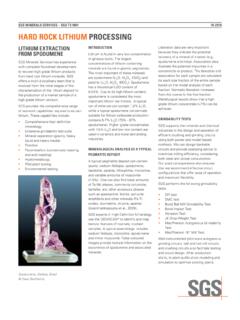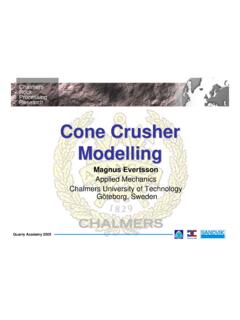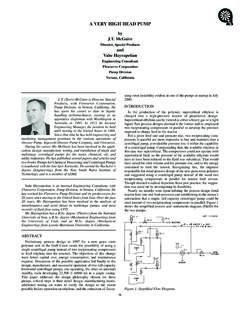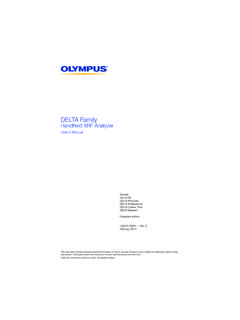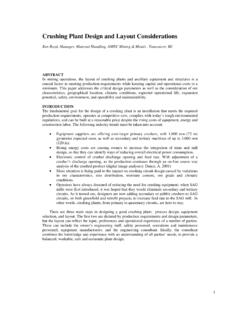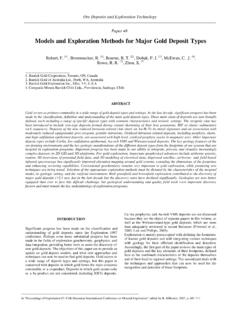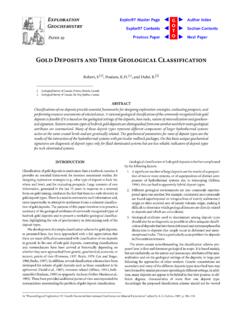Transcription of MIXER MECHANICAL DESIGN—FLUID FORCES
1 Ronald J. Weetman is Senior ResearchScientist at LIGHTNIN, in Rochester, NewYork. He has 21 patents and is the author of42 publications, including contributions toFluid Mixing Technologyby the last 26 years, he has specialized intheoretical, computational, and experi-mental fluid mechanics as applied tomixing technology. Dr. Weetman developedthe first industrial automated laser Dopplervelocimeter laboratory in 1976, and hasinvented various types of impellers that cover a broad range ofmixing applications. He has also designed unique methods offorming his impellers to optimize manufacture while maximizingprocess gains. Dr. Weetman was named Inventor of the Year inRochester, New York, for 1989, and was chairman of Mixing XIV,NAMF/Engineer Foundation Conference held in Weetman earned a degree from Lowell TechnologicalInstitute, an degree from MIT, and a degree( MECHANICAL Engineering) from the University of Gigas is Principal ResearchEngineer at LIGHTNIN, in Rochester, NewYork.
2 Over the past 16 years he has heldvarious positions in Process Engineering,Application Engineering, and Research &Development. His current research focus ison process and MECHANICAL reliabilityimprovements for mixers in high power,high volume gas-liquid-solid applicationsand process Gigas earned a degree(Chemical Engineering) from the University of Rochester and hascompleted graduate work ( MECHANICAL and Chemical Engineering)at Rochester Institute of Technology and the University paper describes the MECHANICAL design of a MIXER with theemphasis on the fluid FORCES that are imposed on the impellers bythe fluid continuum in the mixing vessel. The analysis shows thatthe FORCES are a result of transient fluid flow asymmetries acting onthe mixing impeller. These loads are dynamic and are transmittedfrom the impeller blades to the MIXER shaft and gear reducer. Ageneral result for the form of the fluid force equation can bedeveloped.
3 The importance of the MECHANICAL interaction of themixing process with the mixing vessel and impeller is interaction is shown in a number of force amplification resulting from system dynamics of themixer and tank configuration are addressed. The role ofcomputational fluid dynamics in MIXER process and mechanicaldesign is shown. Several experimental techniques are described tomeasure the fluid FORCES and validate MIXER MECHANICAL MIXER design is often thought of as the application of twoengineering disciplines in sequence. The first step is process designfrom a chemical perspective and involves the specification of theimpeller configuration, speed, temperature, and pressure, etc. Thebasic need in this step is to make sure the installed unit operationperforms the necessary process tasks. Common processspecifications are: Mild blending of miscible fluids High viscosity blending Solid suspension or dissolution Liquid-liquid dispersion and/or mass transfer Gas-liquid mass transfer Heat transferThe process design basics are well understood for each of theseprocesses independently, but the simple descriptions above rarelyapply as a single process requirement.
4 Often, multiple requirementsexist such as gas-liquid mass transfer and heat transfer in thepresence of a solid catalyst. For these applications the processdesign of the MIXER is complex. While it is not within the scope ofthis paper to cover the steps necessary to assure a proper processdesign, the impact of decisions made at the process design step onthe MECHANICAL design requirements must be second step in the design sequence is the MECHANICAL designof the MIXER components. The fundamental approach is straight-forward, design for power (torque and speed), then shaft loads, andfinally MIXER dynamics. For larger systems above 100 hp it may beprudent to perform a MIXER /vessel system modal analysis (finiteelement anaylsis (FEA)) to avoid unexpected interactions. Thesimplicity of this sequence however does not address thecomplications introduced by multiple process requirements, liquidor gas feeds, unusual vessel features, and so on.
5 General testprocedures and design methodology are based on the assumptionthat the loading on the MIXER and vessel components aregeometrically symmetric and temporally invariant a conditionthat is often not met. The following discussions show the approachused to develop fundamental MIXER design rules, as well as pointout several potential pitfalls due to asymmetry in the mixerinstallation and their impact on fluid FORCES . It is not possible tocover all possible arrangements in a single paper. The authors main purpose here is to offer basic guidelines and point out the203 MIXER MECHANICAL DESIGN FLUID FORCESbyRonald J. WeetmanSenior Research ScientistandBernd GigasPrincipal Research EngineerLIGHTNINR ochester, New Yorkneed for the MECHANICAL designer of a MIXER to fully understandthat process parameters can impact the integrity of the design of mixers usually consists of a prime mover, gearreduction unit, a shaft, and impellers.
6 Most of the installations haveoverhung shafts, , without a steady bearing to support the freeend of the shaft. Figure 1 illustrates the FORCES acting on theimpeller and shaft configuration. The main FORCES are torque,bending loads, and thrust. The other major analysis in the design isthe vibration characteristic of the MIXER , especially the shaft sincesystem harmonics can lead to amplification of any of the majorforces. In practical MIXER design, the main critical components areusually bending loads on the shaft and blades and the systemvibration 1. Fluid FORCES Acting on a discussed above, MIXER applications are varied. With thesesvarious processes occurring, the fluid motion in the tank isunsteady. This means that the loads on the individual impellerblades as well as the shaft, reducer, and motor are current fluctuation at the motor is 5 to 15 percentfrom the mean. Typical load fluctuation on the shaft is about twicethis and impeller blade load fluctuation is four times what occursat the motor.
7 An example of this, an extreme case, is shown inFigure 2 where the fluctuation of the bending loads is fullyreversing. The bending load has very little DC component and istruly a highly oscillating signal. Figure 3 shows the correspondingblade loading, which varies from zero to 200 percent of the mean,or fluctuating 100 percent. The torque signal, which is varyingthe least, is also shown in Figure 3. The signals were taken fromstrain gauges mounted on the upper part of the shaft. This examplehas a highly fluctuating load, which will be discussed further inone of the case studies. It shows clearly that loading on theindividual blades can be as high as 100 percent although currentfluctuations of only 15 percent are observed at the job of the design engineer is to be aware of the impact ofmixing process conditions on these highly oscillating loads andtheir impact on MIXER OF INTERACTION OFPROCESS AND MECHANICAL DESIGNSome mixing applications like mild blending seem relatively calmwhen viewed strictly from the smooth liquid surface commonlyfound in these applications.
8 Even with this seemingly calm motion,there are severely fluctuating loads on the blades as discussed above, , 40 percent. Depending upon the magnitude and dynamics ofthe resultant bending loads on the MIXER system, care is neededFigure 2. X-Bending, Y-Bending, and Resultant Bending on a 3. Torque and Blade Loading on a MIXER Shaft and Blade. in the design of the individual MIXER components. In addition todesigning for the loads in the shaft, these loads are transmittedthrough the gearbox , mounting structure, and finally the interaction of the process and the MECHANICAL loads isextremely strong. Even in a mild case, the 40 percent loadfluctuations stemming from the liquid flow around the impellerblades are dynamic. These flow fluctuations are shown in Figures4 and 5. Three impellers with their velocity components are shown:an efficient fluidfoil impeller, designated as an A310; a pitchedblade turbine, A200; and a radial impeller called a Rushtonimpeller or R100.
9 These plots exhibit the same dynamiccharacteristic in velocity that was shown for the strainmeasurements in Figures 2 and 3. Thus, even with mild blending,large velocity fluctuations occur in the flow field adjacent to theimpeller blades. As the impeller blades travel through this turbulentflow field, the fluctuations are transmitted into dynamic bladeloading. Later discussion will show that these blade fluctuations(acting out of phase) cause asymmetric loading of the shaft andhence lead to a net bending load on the MIXER shaft. This bendingload is one of the predominant design loads for a mixing fluctuating velocity components are measured with a laserDoppler velocimeter using laser beams as shown in Figure 6. Amean velocity map of the velocity profile is shown in Figure 7. Herea pitched blade turbine (A200) velocity field is shown passing bythe impeller blade and then out toward the tank wall.
10 Note the up-flow underneath the impeller in the center of the tank. Alsoillustrated in this figure is a force F,the main fluid force componentthat creates the large bending moment and Nindicating impellerrotational speed. Other items on this graph show the main flowthrough the impeller diameter at 2200 gpm, the total flow, definedas the primary flow underneath the impeller plus the entrained flow,and maximum and average shear gradients of the velocity OF THE 19TH INTERNATIONAL PUMP USERS SYMPOSIUM204 Shaft VibrationTorqueBendingThrustMIXER MECHANICAL DESIGN FLUID FORCES205 Figure 4. Outlet Velocity of Main Velocity Component Versus Timefor A310, A200, and R100 5. Outlet Velocity of Perpendicular Component Versus Timefor A310, A200, and R100 6. Laser Velocimeter Taking Velocity Measurements of aMixing impeller blades have different characteristics as onemight expect. Figures 8 and 9 show flow streaming around anairfoil at different angles of attack (angle between the approachingflow and airfoil chord line).
